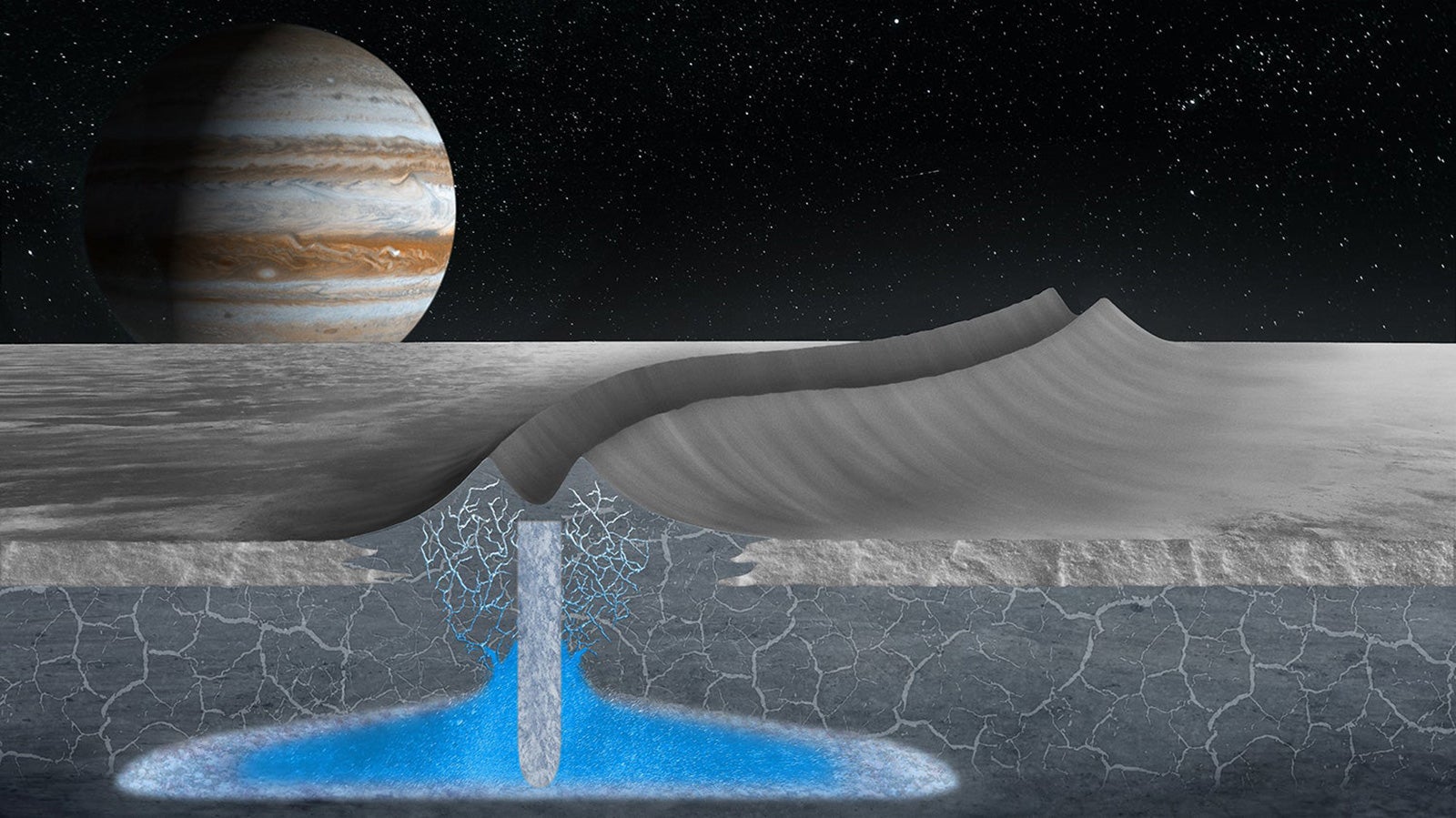Jupiter’s moon Europa may have a habitable ice shell
(CNN) — On Jupiter’s moon Europa, a saltwater ocean exists deep beneath a thick ice shell. Now, a surprising connection between the ice shell and the Greenland ice sheet on Earth has provided new insight: Europa’s ocean may be habitable, according to a new study.
Scientists have been intrigued for more than 20 years by dramatic gashes on Europa’s icy surface. These double ridges have crests that can reach almost 1,000 feet (305 meters) high, with wide valleys between them. These features were first imaged by the NASA Galileo spacecraft in the 1990s, but researchers haven’t been able to determine how they formed.
While studying the Greenland ice sheet using ice-penetrating radar observations, a team of researchers observed a similar double-ridge feature shaped like the letter M that’s like a miniversion of the one on Europa.
A study detailing the findings published Tuesday in the journal Nature Communications.
Water’s impact on ice sheet topography
Airborne instruments help researchers study Earth’s polar regions to watch changes in ice sheets that could have an effect on the global sea level. These eyes in the sky also look for ponds of surface meltwater, conduits that carry seasonal drainage and subglacial lakes.
“We were working on something totally different related to climate change and its impact on the surface of Greenland when we saw these tiny double ridges — and we were able to see the ridges go from ‘not formed’ to ‘formed,’ ” said study senior author Dustin Schroeder, an associate professor of geophysics at Stanford University’s School of Earth, Energy & Environmental Sciences, in a statement.
Operation IceBridge — a NASA mission that collected surface elevation and radar data of the ice sheet between 2015 and 2017 — revealed that Greenland’s double ridge formed after the ice fractured around water that was refreezing inside the ice sheet. The pressure of the water pocket caused the distinct peaks to rise.
This led researchers to question if the same thing would be possible on Europa, where pockets of water could exist beneath the ice shell — and create potentially habitable environments on the otherwise inhospitable shell of the moon.
“In Greenland, this double ridge formed in a place where water from surface lakes and streams frequently drains into the near-surface and refreezes,” said lead study author Riley Culberg, a doctoral student in electrical engineering at Stanford, in a statement.
“One way that similar shallow water pockets could form on Europa might be through water from the subsurface ocean being forced up into the ice shell through fractures — and that would suggest there could be a reasonable amount of exchange happening inside of the ice shell.”
An ever-changing lunar surface
Europa appears to be a dynamic place, where plumes of water rise up through cracks in the ice shell, which is tens of miles thick. And this ice shell could be a place where the subsurface ocean and nutrients mix together.
“Because it’s closer to the surface, where you get interesting chemicals from space, other moons and the volcanoes of Io (another moon that orbits Jupiter), there’s a possibility that life has a shot if there are pockets of water in the shell,” Schroeder said. “If the mechanism we see in Greenland is how these things happen on Europa, it suggests there’s water everywhere.”
This was the first time that scientists were able to watch something similar happen on Earth and actually observe the subsurface processes that led to the formation of the ridges, Culberg said.
“The mechanism we put forward in this paper would have been almost too audacious and complicated to propose without seeing it happen in Greenland,” Schroeder said.
The broad data the team has already collected on Greenland’s ice sheet may allow them to use it as an analog for the dynamic processes occurring on Europa in the future as well.
The temperature, chemistry and pressure are different on Europa when compared to Greenland, so the team want to investigate how these water pockets work on Europa.
Europa is a target of two upcoming missions, the European Space Agency’s JUICE (short for the Jupiter Icy Moons Explorer) and NASA’s Europa Clipper. Clipper will carry ice-penetrating radar, similar to how the researchers studied Greenland, to collect subsurface imaging of Europa’s ice shell.
Europa stands out as one of the best candidates for hosting extraterrestrial life in our solar system due to the liquid water in the subsurface ocean and what scientists understand about its chemistry, Culberg said.
